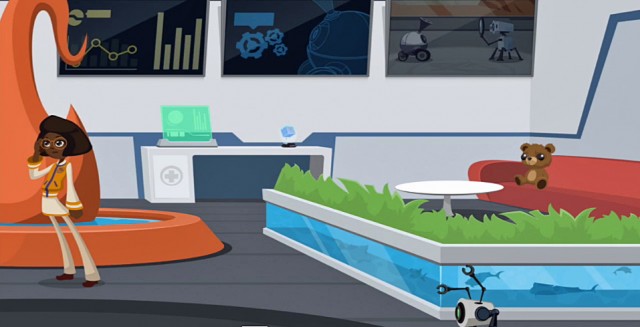Mars Generation One: Argubot Academy is a role playing game that combines a space-age storyline about building a Mars colony with great animations. It engages students in a topic that is often hard to contextualize. While we ordinarily demand that students demonstrate argumentation skills in expository writing, modern education practices rarely approach it in such an explicit way.

“By teaching ELA standards through a STEM-themed storyline, the game is fundamentally interdisciplinary in all the right ways," wrote Patricia Monticello Kievlan, a San Francisco classroom teacher who reviewed the game for Graphite. "Showing students how these skills bridge disciplines is a critical lesson, and that point is deftly delivered.”
Argubot Academy is a great short-form tablet game that many teachers use to add contextualized interactive practice to your existing ELA curriculum (grades 6-8). John Paul Sellars, a fifth grade teacher who used the game during this past year at Red Bank Elementary School in Lexington, South Carolina, says his students “loved the ability to combine gaming with their learning.”
Classroom Modifications
Teachers are also using commercial games that have been modified for classroom use. Perhaps the most famous is MinecraftEDU. This classroom-ready modification of the popular sandbox game is not only less expensive than the commercial version, it also provides many tools that empower teachers with the ability to adapt gameplay to established class curricula.
Joel Levin, one of the creators of MinecraftEDU, uses it with second graders. But it works with students of any age. What makes MinecraftEDU great for teachers is the same thing that makes it so popular among gamers: it is so open-ended that that the possibilities are only limited by your imagination. Search the web and you’ll find thousands of examples of teachers using MinecraftEDU.
MinecraftEDU provides a virtual world where teachers and students can build simulations with unlimited resources. When I was a student, we held mini-Renaissance Faires and built toothpick bridges. We were always limited by time, space, and resources. In today’s Minecraft-equipped classrooms, both teachers and students build entire multi-player worlds full of interactive scenarios. For example, when I visited the Quest to Learn school in NYC at the end of their school year, I saw final projects that used Minecraft in their presentations. One class used Minecraft-polar-ice blocks to model the potential impact of global warming. Another demonstrated their understanding of urban water treatment and sewage engineering by building a working system out of pixelated blocks and then simulating rainfall and flooding.
Commercial Games
Most teachers and parents are on board with games that are manufactured or modified for educational purposes. But what about big, bloody, shoot-'em-up commercial games? Could they also be put to use in a classroom?
Consider Norwegian high school teacher Tobias Staaby. He’s a relative newbie in the classroom. But it may actually be to his advantage that he’s only been teaching for two years; he doesn’t feel like he’s got it figured out yet. “I’m constantly searching for new ways to improve my classes, and to engage and motivate my students,” he says. One thing that has worked is using zombie-themed video games to teach moral philosophy and ethical theories. “I was looking for a way to make these concepts easier to understand without oversimplifying the material.”
One of the hardest things about facilitating class discussions about ethics is presenting engaging dilemmas that they haven’t “necessarily thought or heard much about, thus making their arguments and decisions much more their own.” Staaby settled on using The Walking Dead video game by Telltale Games.
Loaded on his personal laptop and streamed through the classroom projector, Staaby boots up The Walking Dead and hands the controller to a student. The rest of the class shouts commands at the player. Then, whenever the game presents an ethical dilemma, they “pause the game and discuss the next course of action using the ethical models and theories they had learned earlier that year -- relational ethics, consequential ethics, ethics of virtue, and ethics of duty -- as a basis for their arguments.” What started as Staaby’s spontaneous unplanned class exercise quickly evolved into a rigorous project. He now prepares short lectures and ties ethical theories to specific dilemmas within the game. (More about Staaby and his school in a soon-to-be-published MindShift article.)
There is research to support Staaby’s intuitive findings. A recent study out of the University at Buffalo Department of Communication, Michigan State University, and the University of Texas, Austin says that playing violent video games may increase moral awareness. "Our findings suggest that emotional experiences evoked by media exposure can increase the intuitive foundations upon which human beings make moral judgments." Says Matthew Grizzard, one of the study’s authors. Imagine it like a low stakes practice run; simulated opportunities to practice moral and ethical decision making can teach individuals to iterate their initial reactions and make better choices in the future.
In Jerome and Donna Allender’s new book Ethics for the Young Mind: A Guide for Teachers and Parents of Children Becoming Adolescents, they write about the importance and challenges involved in teaching ethics. Their work reminds us that it all comes down to considering “responses to otherness.” When the bell rings at the end of the day, isn’t this what school is all about? We not only want to raise caring individuals, but we also want to provide our students with the skills necessary to maintain fulfilled work-a-day lives. Becoming an ethical person requires “learning more about connecting with others in ways that satisfy our needs and wants while attending to those of others.”
The common attribute of all effective learning games is that they simulate systems. They teach students how to understand academic concepts in relationship to the world around them. Certainly this increases engagement and retention, but what really matters is that it is about using knowledge in an inter-disciplinary way.
Digital or analog, game-based or not, good teaching and learning is about building social awareness, considering the individual’s impact on a wider world.


